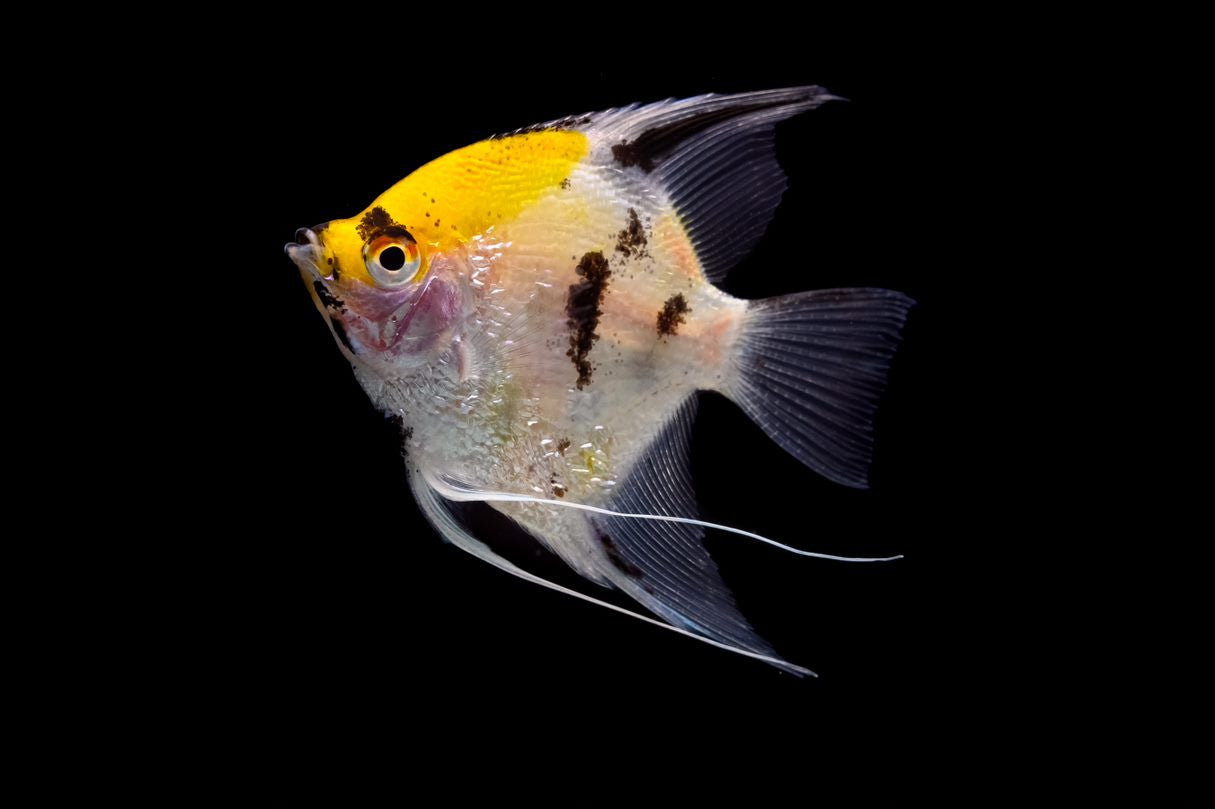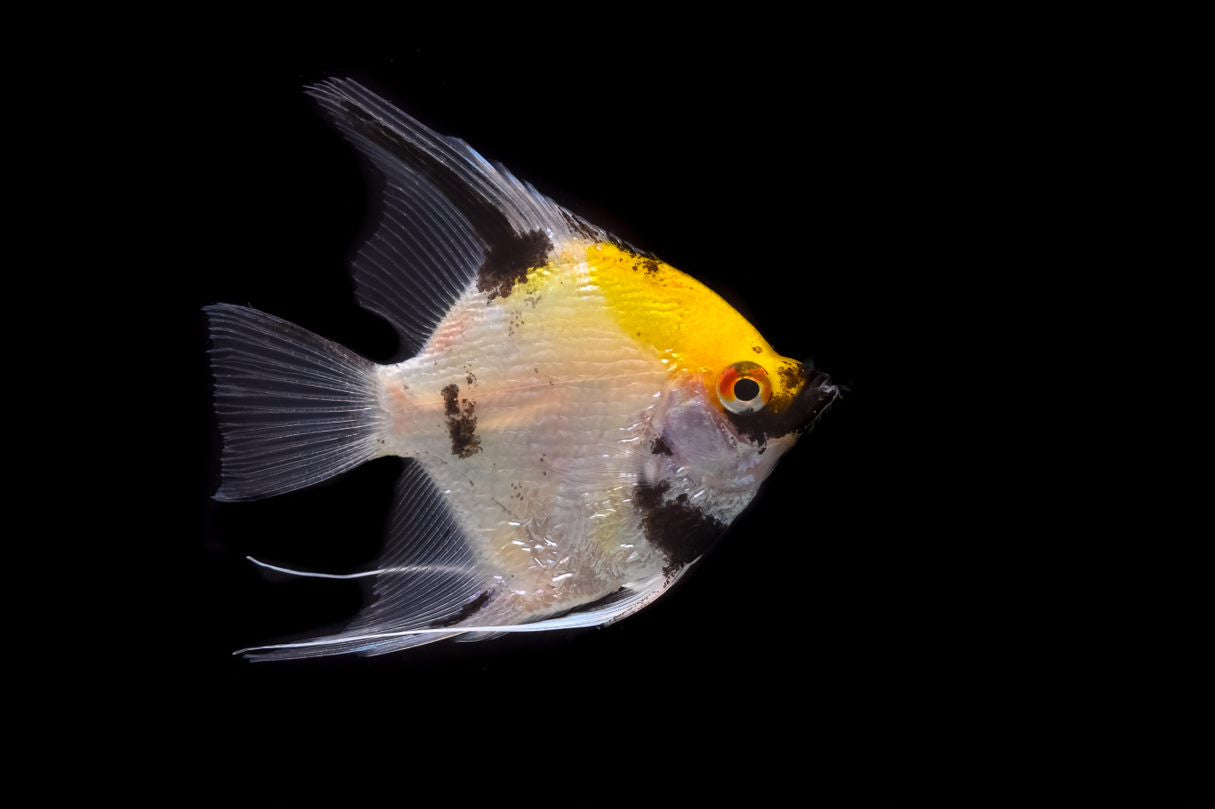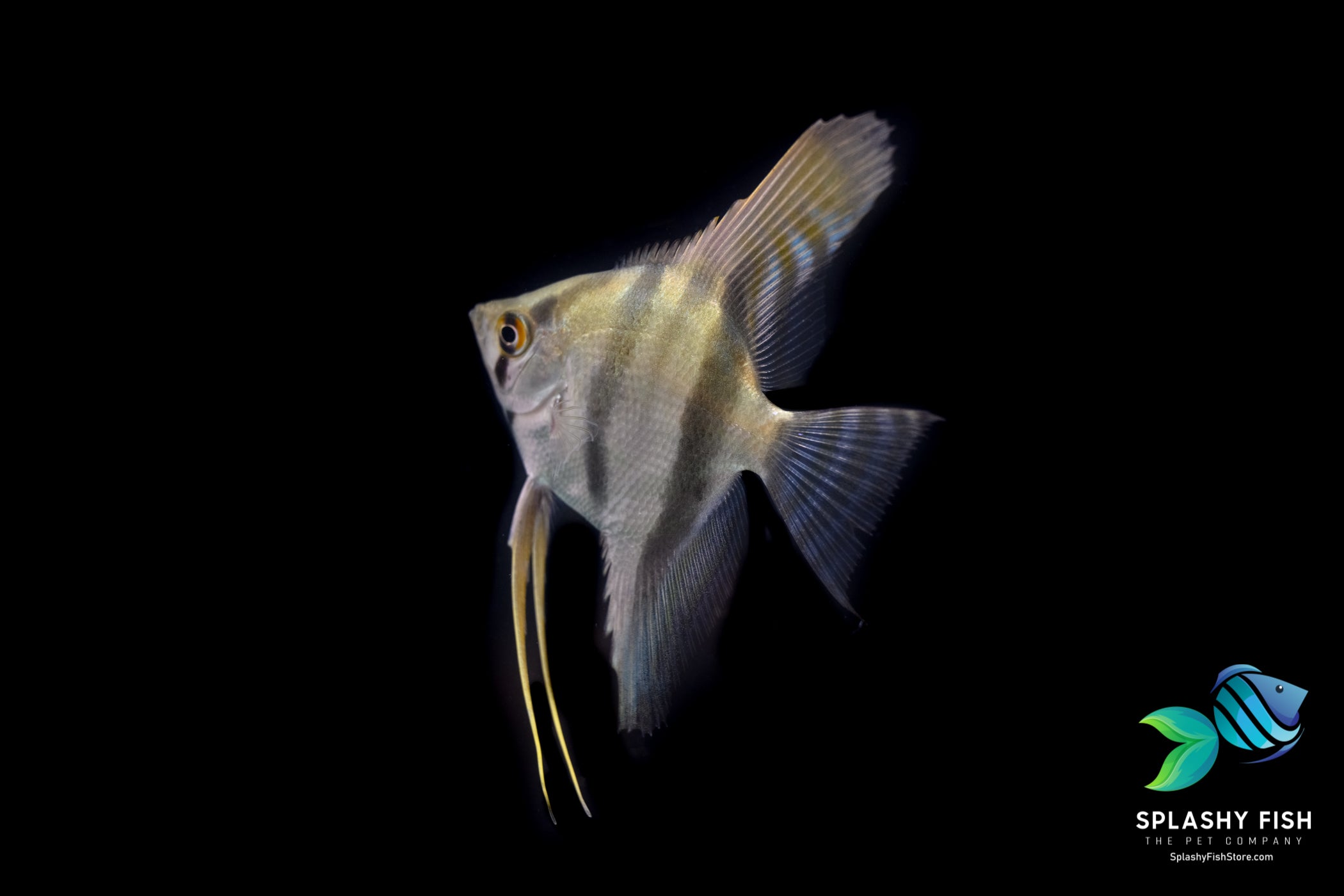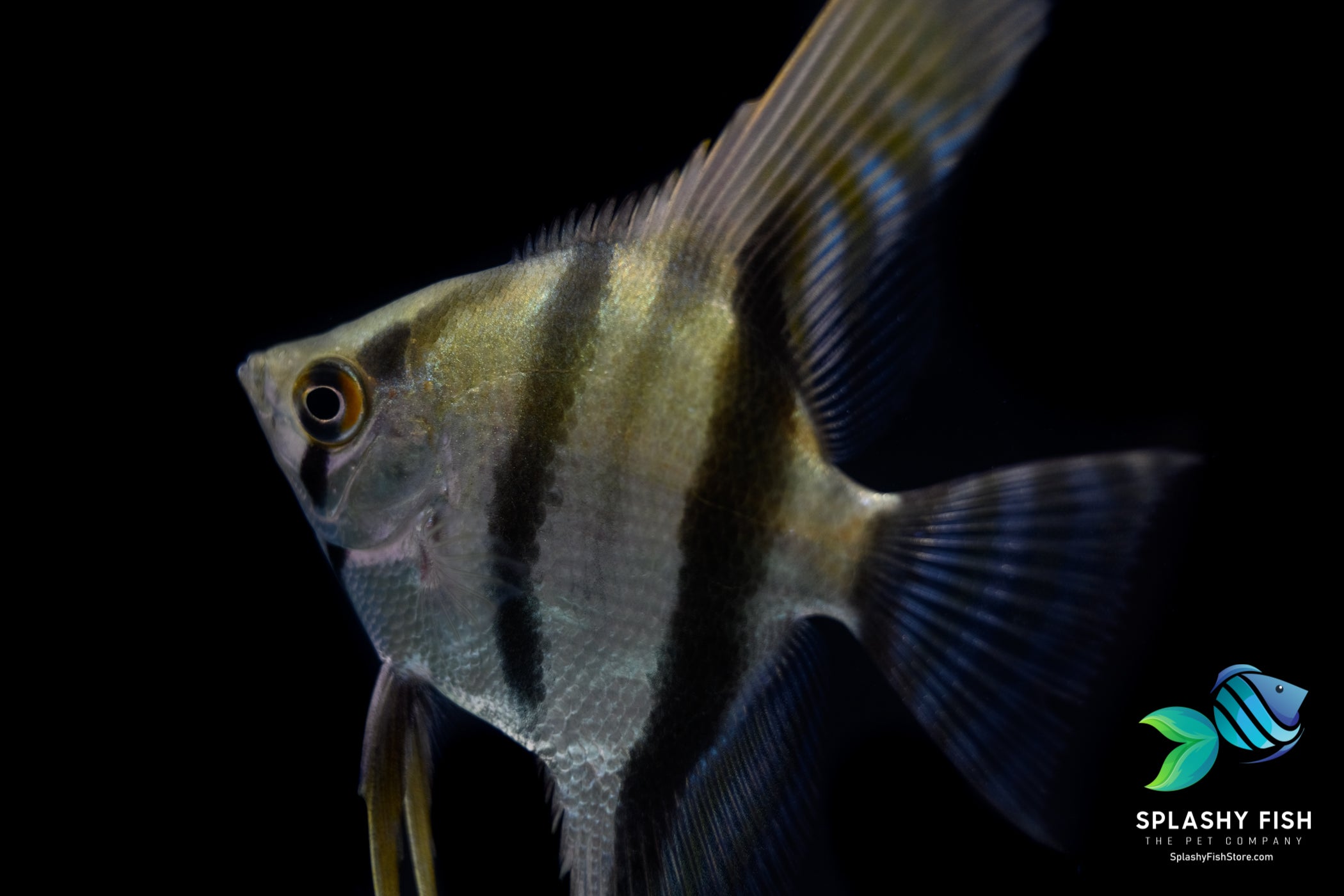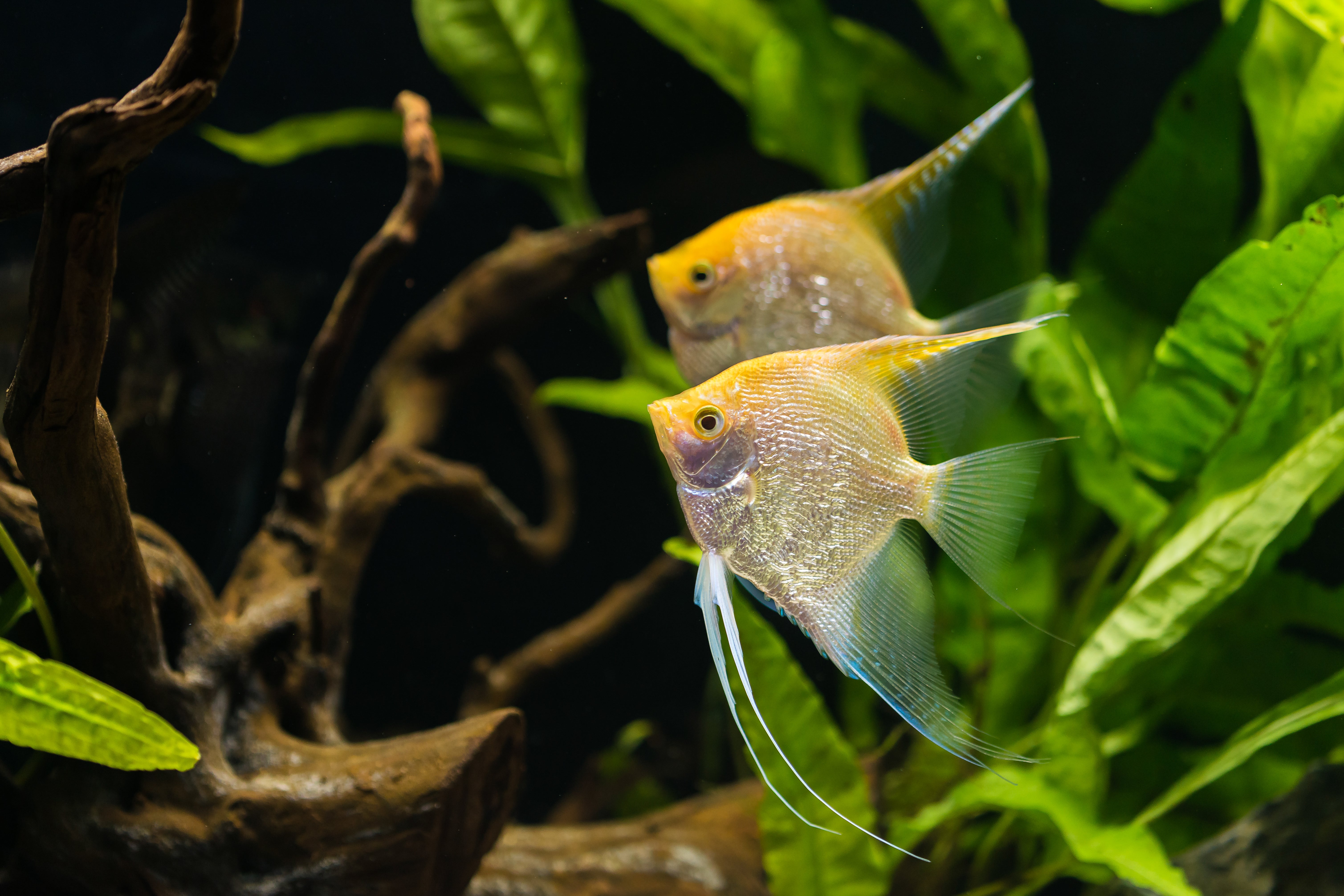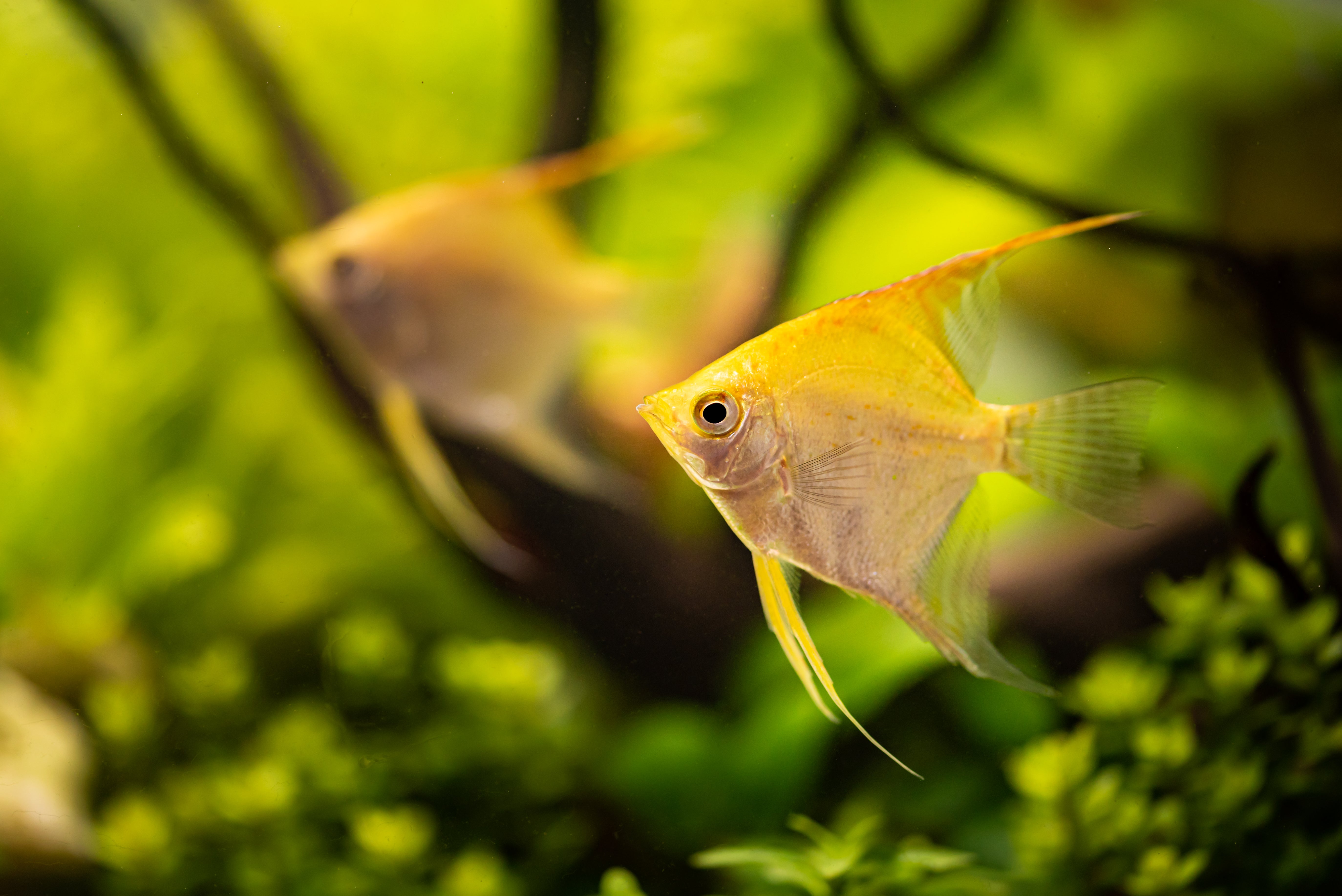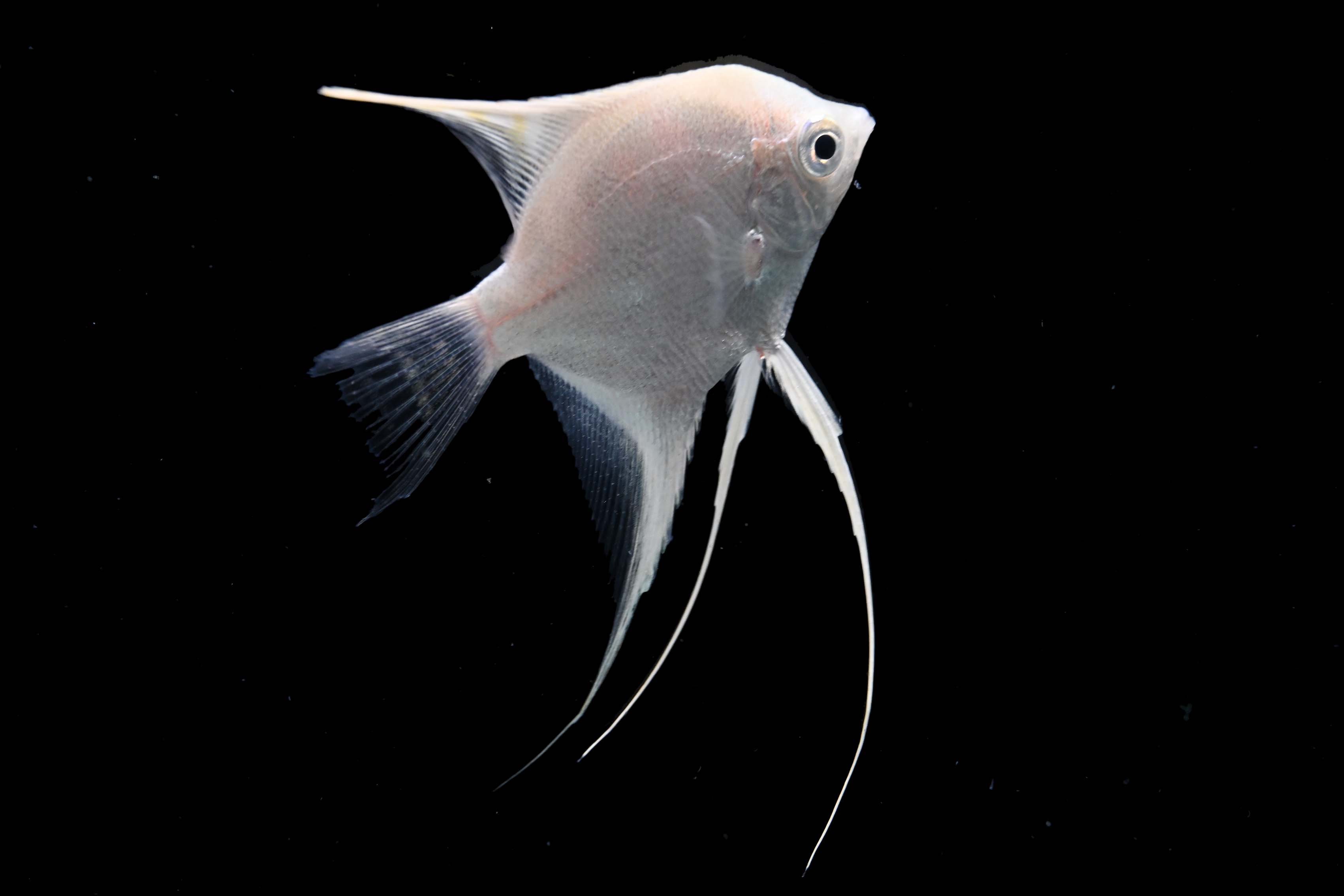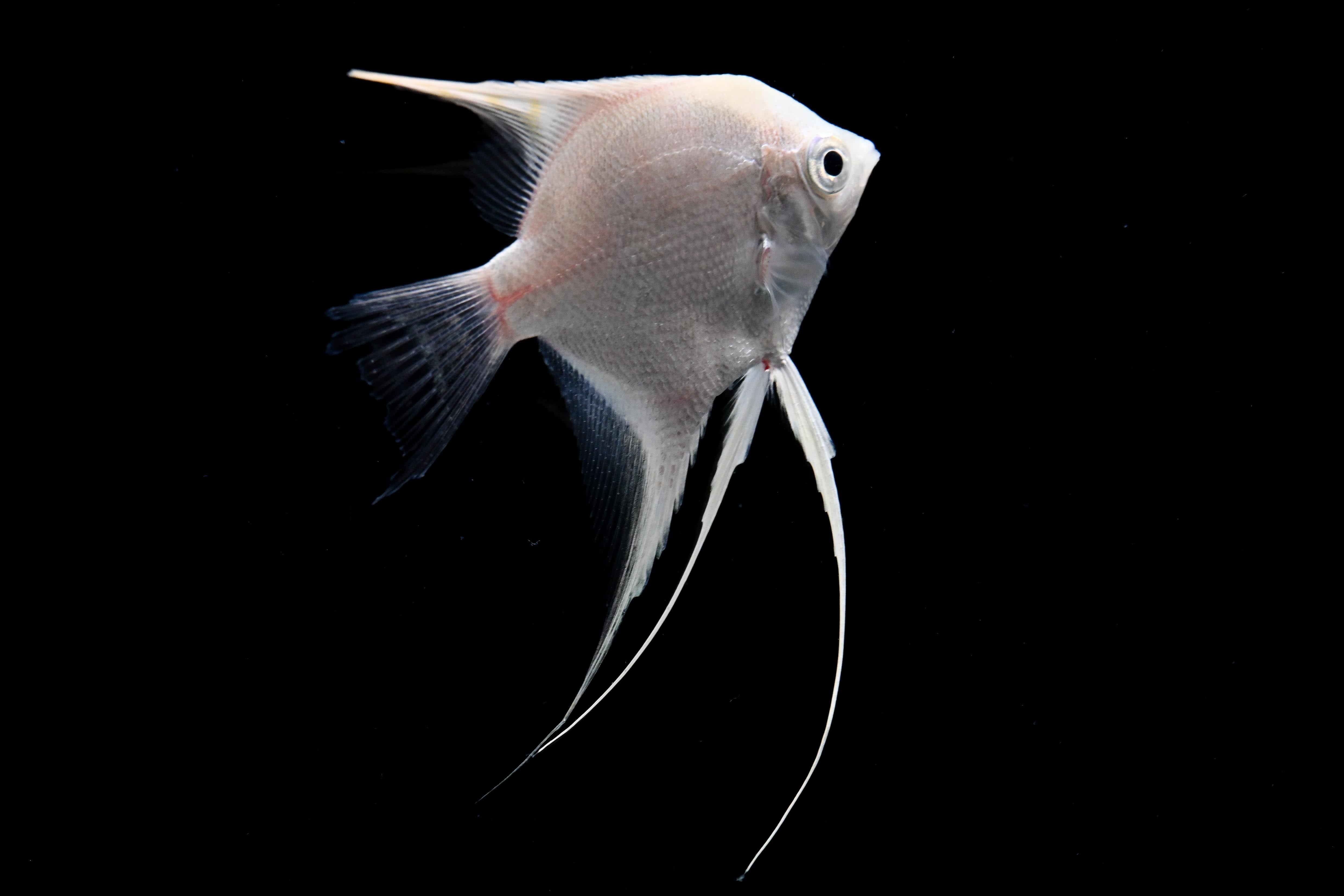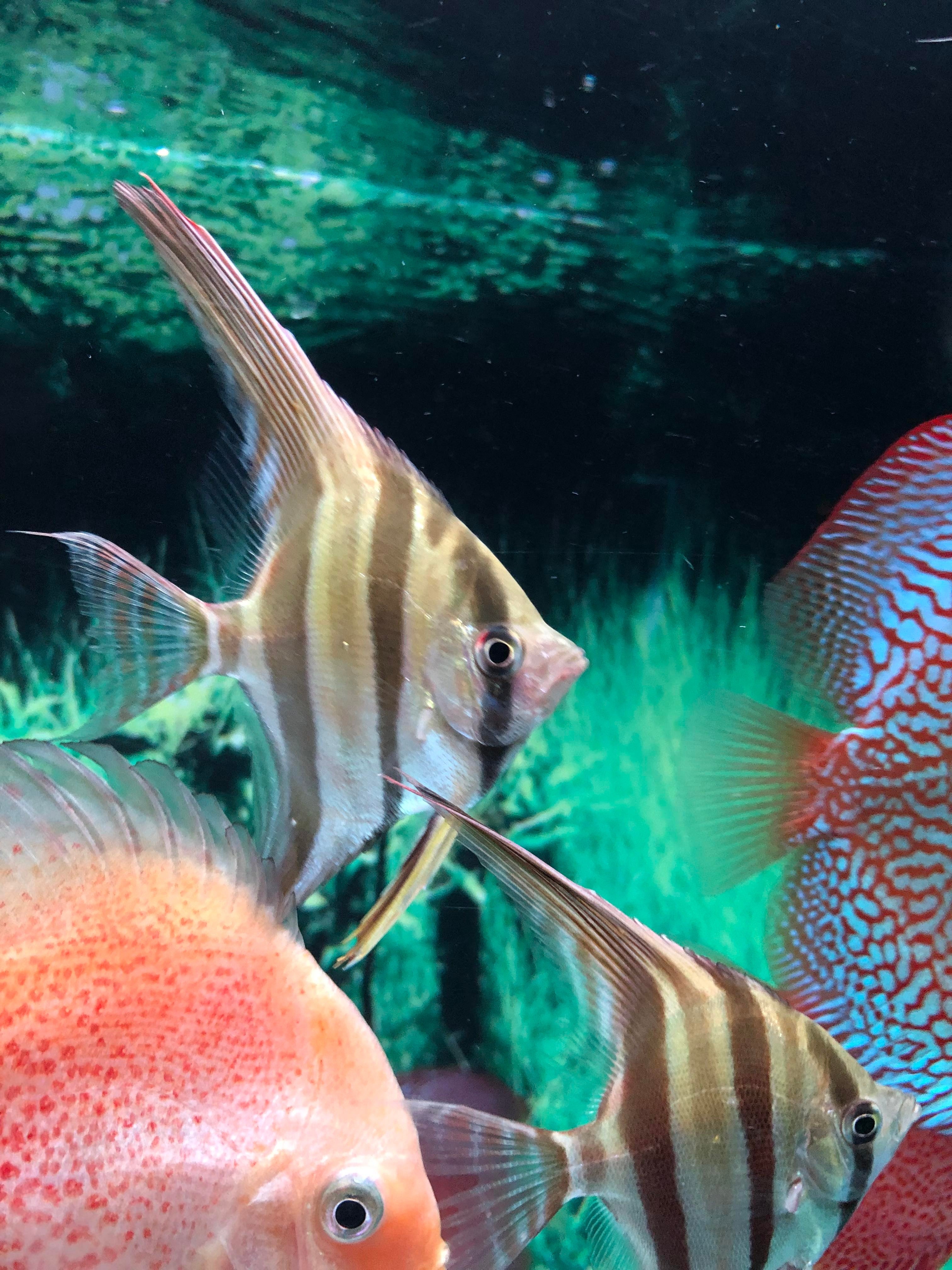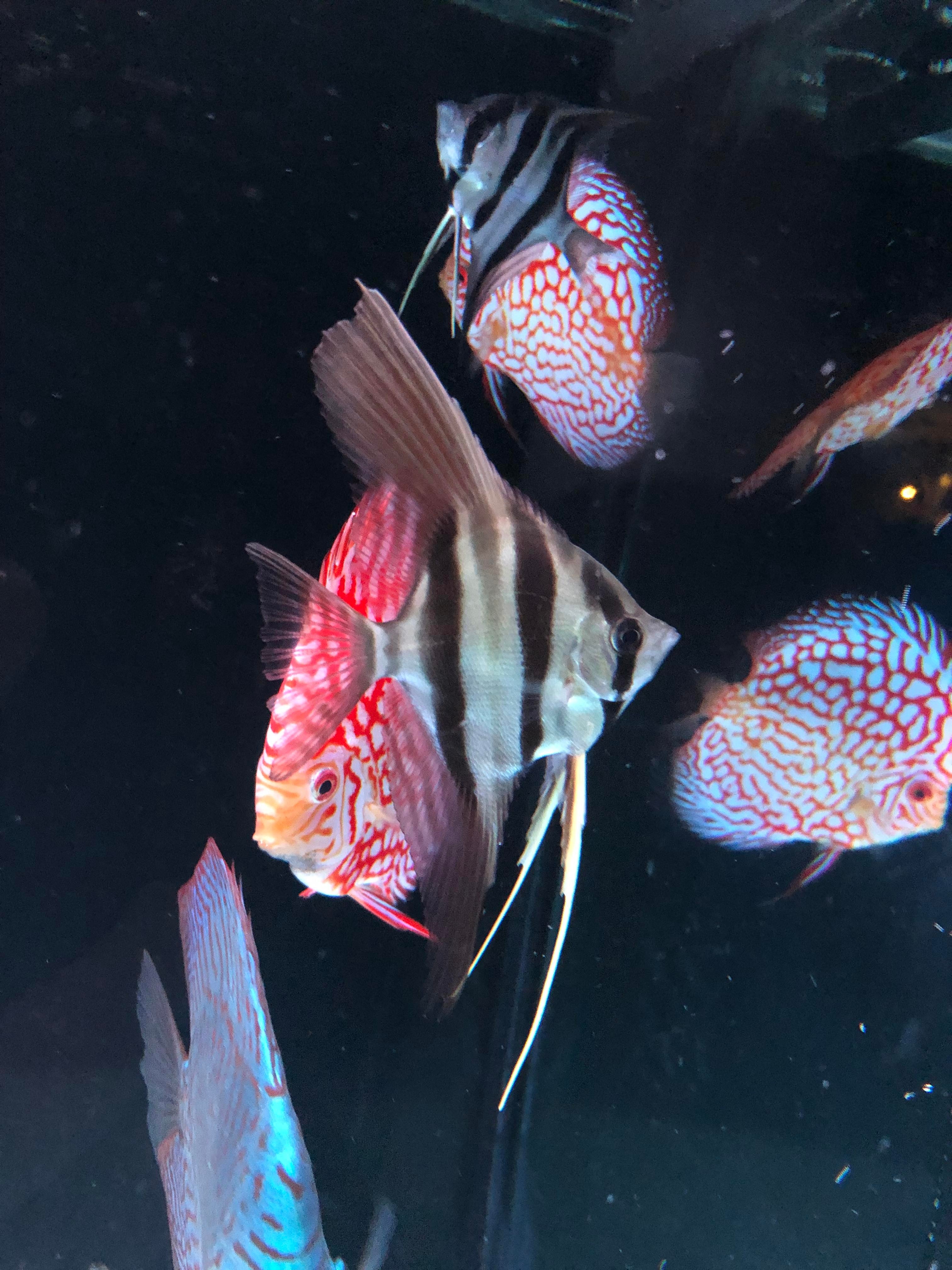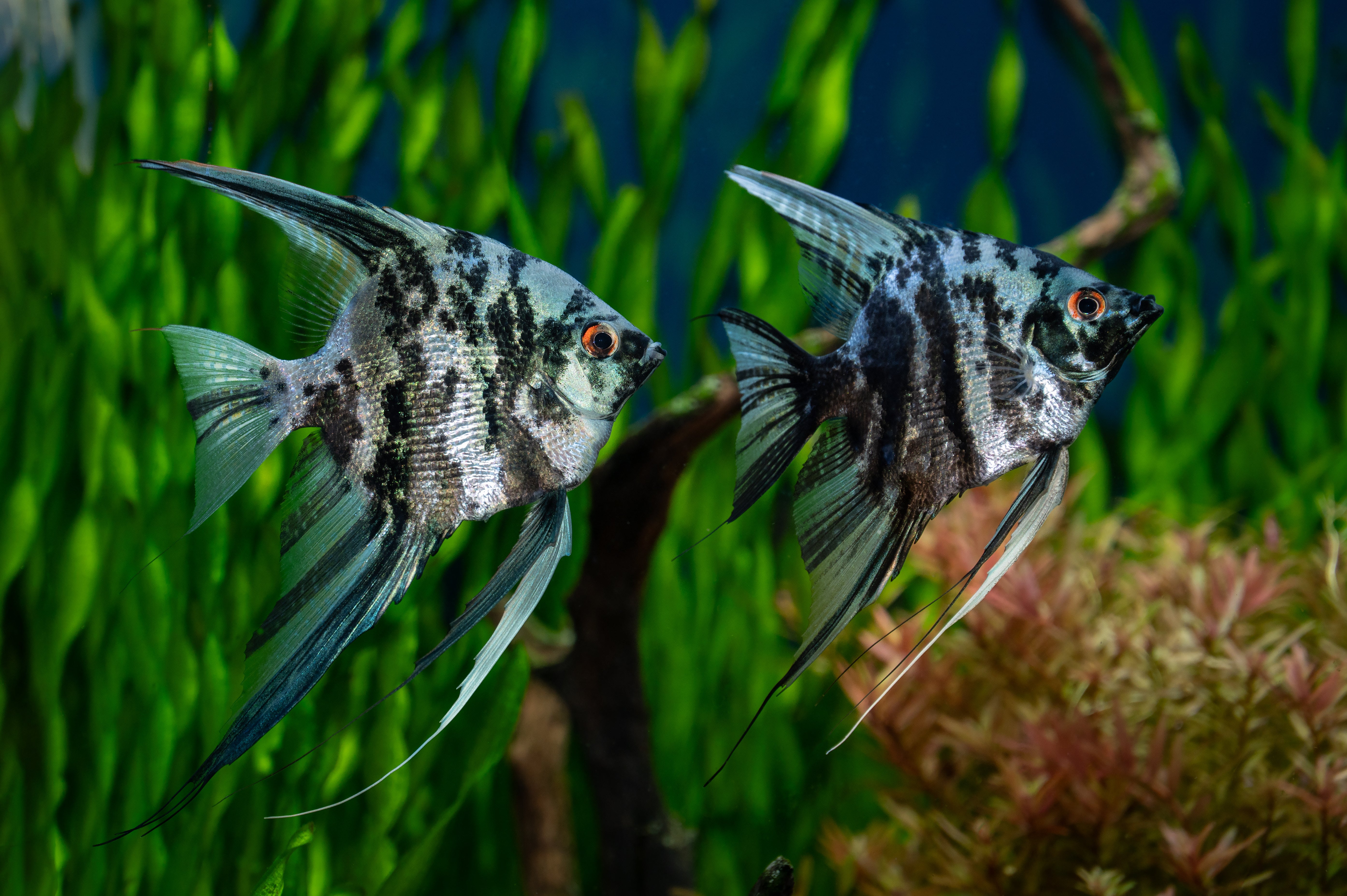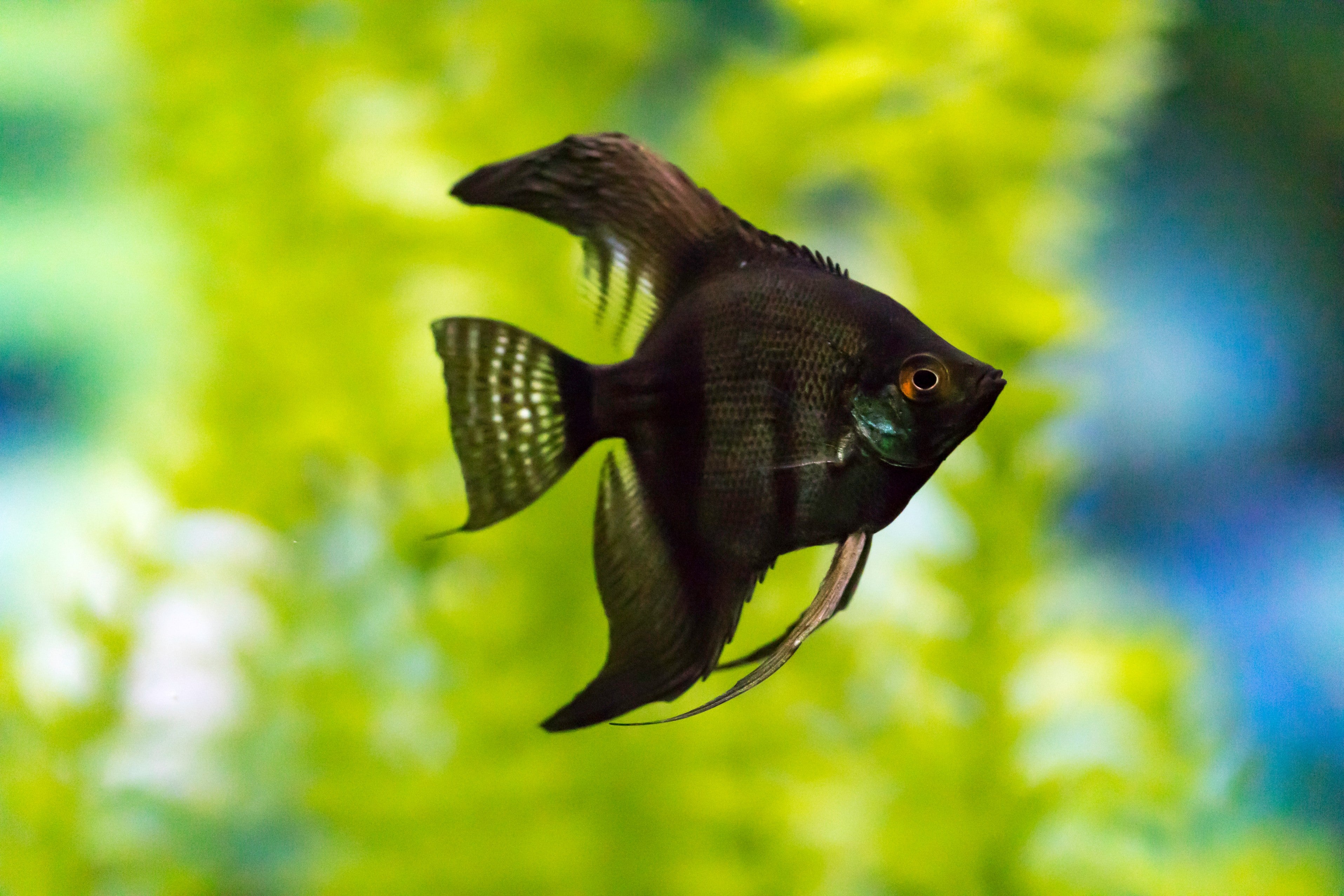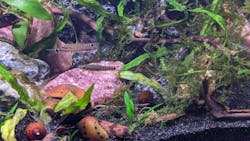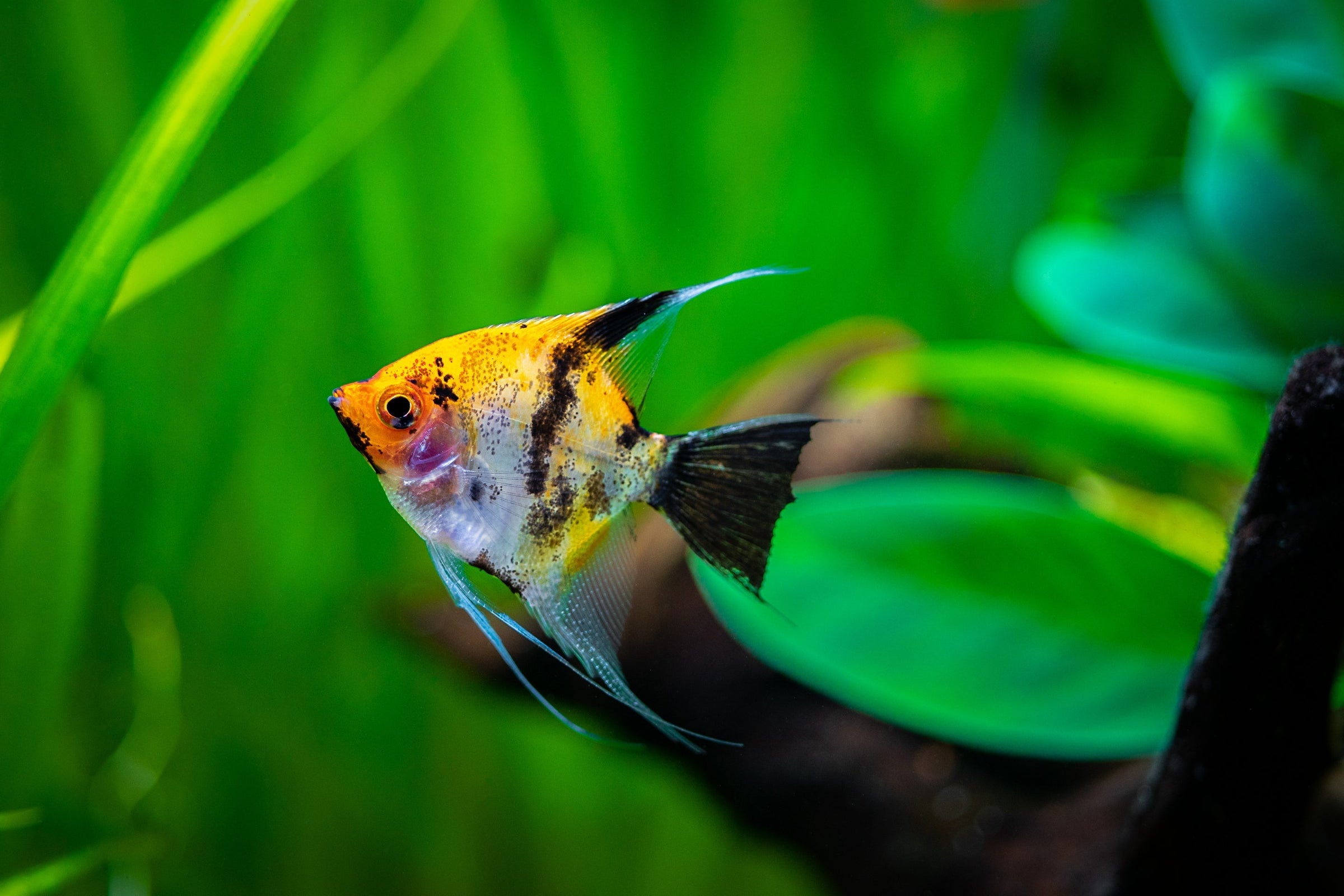
Angel Fish
Angelfish are a type of tropical freshwater fish known for their beautiful, flowing fins and vibrant colors. These popular aquarium fish are native to the Amazon River in South America and are popular among aquarists for their stunning appearance and peaceful nature. Angelfish come in a variety of colors, including silver, gold, black, and even blue, and their long, flowing fins can range in length and shape, giving them a graceful, elegant appearance. In addition to their beautiful appearance, angelfish are also known for their intelligence and personality, making them a great choice for a pet fish. Whether you're an experienced aquarist or new to the hobby, angelfish makes a great addition to any fish tank. Their peaceful nature makes them a good choice for community tanks with other non-aggressive fish species, and their vibrant colors add a splash of beauty to any aquarium.
At Splashy Fish tropical fish store, our Angel Fish for sale are carefully hand-picked and packed with love to ensure they reach you in the best condition. You can buy angelfish online or visit our fish store in Virginia for a wide range of freshwater fish for sale, live plants for sale, and other aquarium supplies.
Care Guide for Angel Fish
- Tank Size: Due to their size and active swimming habits, Angelfish requires a spacious aquarium. A minimum tank size of 20 gallons is recommended for a single Angelfish, with an additional 10 gallons for each additional fish. Tall tanks are preferred to accommodate their vertical body shape.
- Water Parameters: Angelfish thrive in warm, slightly acidic to neutral water. Aim for a pH of 6.5-7.5, water hardness of 3-8 dGH, and a temperature range of 78-84°F (25-29°C).
- Filtration: A reliable filtration system is essential to maintain water quality for Angelfish. Use an aquarium filter rated for the tank size and consider adding an air stone for additional oxygenation.
- Aquarium Decorations: Angelfish appreciates a well-decorated aquarium tank with tall aquatic plants, rocks, and driftwood to create hiding spots and territories. Provide vertical structures for them to swim amongst.
- Lighting: Moderate aquarium light is sufficient for Angelfish. Avoid excessive light, which may cause stress. Consider adding floating plants to provide shade.
- Diet: Angelfish are omnivores and enjoy a varied diet. Offer them high-quality flake food or pellet food supplemented with live or frozen foods like brine shrimp, bloodworms, and daphnia.
- Tankmates: Choose tankmates carefully, as Angelfish can be territorial and may harass or bully smaller, more passive fish. Suitable tankmates include other cichlids of similar size, peaceful bottom-dwellers like Corydoras, and some larger types of tetras.
See more details on How to Care for Angelfish here.
Angel Fish Frequently Asked Questions FAQs
Are Angel Fish aggressive?
Angelfish can exhibit territorial and aggressive behavior, especially during breeding or when housed in overcrowded conditions. However, with proper care and tank setup, they can coexist peacefully with appropriate tankmates.
How many Angelfish should be kept together?
It's best to keep Angelfish in pairs or small groups of 4-6 individuals to establish a social hierarchy and reduce aggression.
How long can Angelfish live?
With proper care, Angelfish can live for 10 years or more in a home aquarium. Providing them with a suitable environment, a balanced diet, and regular maintenance will contribute to their longevity and well-being.
Unleashing the Secrets: A Comprehensive Guide to Advanced Care for Angel Fish
Get ready to dive into the world of advanced care for your angel fish! In this comprehensive guide, we'll unveil the secrets to keeping these beautiful creatures happy and healthy. Whether you're a seasoned fish owner or just starting out, this article is packed with valuable tips and techniques that will take your fishkeeping skills to the next level. We cover everything from tank setup and water quality to diet and disease prevention. Discover how to create the perfect environment for your angel fish to thrive, complete with the ideal temperature, pH levels, and filtration system. Learn the best feeding practices to ensure a nutritious and balanced diet, and find out how to spot and treat common diseases before they become serious. Our goal is to provide you with the knowledge and tools to maximize the longevity and vibrancy of your angel fish. So, grab your nets and get ready to unlock the secrets of advanced care for these enchanting creatures. Let's dive in and create a thriving underwater world for our angel fish companions.
Understanding the Different Species of Angel Fish
Before setting up your tank, it's essential to know which species of angelfish you are dealing with. While Pterophyllum scalare is the most common species kept in aquariums, there are other species worth noting:
- Pterophyllum altum – The Altum Angelfish is larger and more delicate than the scalare. Its tall, angular body and distinctive vertical stripes make it stand out, but it requires pristine water conditions.
- Pterophyllum leopoldi – Also known as Leopold's Angelfish, this species is smaller but more aggressive. It has a more pointed body and demands ample swimming space.
Understanding the specific needs of your angelfish species is crucial to providing the right environment and care.
Setting Up the Perfect Tank for Your Angel Fish
Tank Size
A well-designed tank setup is the foundation of angelfish care. These freshwater fish grow up to 6 inches in length and 8 inches in height, meaning they need plenty of space to swim vertically. The ideal tank size for a group of angelfish should be at least 30 gallons for a small group of 4-6 fish. Larger tanks, such as 55-gallon setups, are better suited for adults.
Tank Decorations and Substrate
Angelfish prefer heavily planted tanks with driftwood and rocks that mimic their natural habitat. Consider using live plants like Amazon swords, Vallisneria, and Anubias, which offer hiding spots and enhance the tank's aesthetic appeal. Choose a soft, sandy substrate to reduce stress and provide a natural environment for your fish to swim comfortably.
Filtration
Since angelfish are sensitive to water quality, invest in a high-quality filtration system. Canister filters or sponge filters provide efficient mechanical, chemical, and biological filtration. Make sure the filter doesn’t create too much water movement, as angelfish prefer slow-flowing water.
Lighting
Moderate aquarium lighting is ideal for angelfish and the live plants in your tank. Use a timer to simulate natural daylight cycles, providing around 10-12 hours of light daily.
Water Parameters and Temperature Requirements
Water quality is the cornerstone of angelfish care. The species originates from the warm, slow-moving waters of the Amazon River Basin, so replicating these conditions is essential for their well-being.
- Temperature: Maintain a temperature between 78°F and 84°F. A reliable heater with a thermostat is essential to maintain stable water temperatures.
- pH Levels: Aim for a slightly acidic to neutral pH between 6.5 and 7.0. Angelfish are sensitive to fluctuations in pH, so avoid sudden changes and always test your water regularly.
- Water Hardness: The ideal water hardness for angelfish is between 3-8 dKH. Soft to moderately hard water is ideal for replicating their natural habitat.
- Ammonia, Nitrite, and Nitrate Levels: Keep ammonia and nitrite levels at 0 ppm and nitrates below 20 ppm. Perform weekly water changes of 25-30% to maintain optimal water quality and remove toxins.
Using a water testing kit and maintaining regular tank maintenance will ensure that the water parameters remain stable and healthy for your angelfish.
Feeding and Nutrition for Angel Fish
Providing a balanced and varied diet is crucial for the long-term health and vibrancy of your angelfish. In the wild, they are omnivorous, consuming small crustaceans, insects, and plant matter. A combination of high-quality commercial food, live food, and vegetables ensures they receive all the necessary nutrients.
Pellets and Flakes
Choose a high-quality pellet or flake food formulated specifically for cichlids or angelfish. Look for products that are high in protein and contain essential vitamins and minerals to support growth and immune function. Feeding angelfish these staple foods once or twice a day will provide them with the necessary nutrients.
Live and Frozen Foods
Angelfish benefit greatly from the addition of live or frozen foods to their diet. Bloodworms, brine shrimp, blackworms, and daphnia are excellent sources of protein and mimic their natural prey in the wild. These fish foods help condition angelfish, especially when preparing for breeding.
Vegetables and Plant-Based Foods
Occasionally supplement their diet with blanched vegetables like spinach, peas, or zucchini. These plant-based foods offer fiber and help support digestive health. You can also offer them algae wafers or spirulina-based flakes.
Feeding Frequency
Feed your angelfish 2-3 times a day, providing only what they can consume within 2-3 minutes. Overfeeding can lead to obesity and poor water quality due to uneaten food decaying in the tank.
Breeding and Raising Angel Fish Fry
Breeding angelfish can be rewarding but requires advanced care. Angelfish are egg-layers and form monogamous pairs. To encourage breeding, you’ll need to create the ideal conditions:
- Tank Setup: Use a separate breeding tank of at least 20 gallons with subdued lighting. Provide broad-leaved plants or breeding cones for the angelfish to lay eggs.
- Water Conditions: Keep the water temperature at around 82°F, with soft, slightly acidic water (pH 6.5-6.8).
- Breeding Behavior: Once paired, the angelfish will clean a surface and lay hundreds of eggs. After fertilization, the parents will guard the eggs.
- Raising Fry: Once the eggs hatch (within 2-3 days), feed the fry infusoria or specialized fry food. As they grow, introduce baby brine shrimp to ensure proper nutrition.
Tank Mates and Compatibility with Other Fish
Ideal Tank Mates for Angelfish
Corydoras Catfish
These bottom-dwelling fish are peaceful and active during the day. Corydoras Catfish helps keep the tank clean by scavenging leftover food and won’t compete with angelfish for swimming space or food. They also thrive in similar water conditions (soft, slightly acidic water).
Dwarf Gouramis
Like angelfish, Gouramis are relatively peaceful, slow-moving fish. Dwarf gouramis prefer calm environments and won’t bother the angelfish. Their similar size makes them an excellent match in a community tank.
Cardinal Tetras or Rummynose Tetras
While some tetra species can be fin-nippers, Cardinal Tetras and Rummynose tetras are generally peaceful and do well with angelfish. They have similar water needs and swim in schools, which adds visual interest to the aquarium.
Bristlenose Pleco
This small, algae-eating catfish is an ideal tank mate for angelfish. They spend most of their time on the tank floor or attached to surfaces, scraping off algae. Bristlenose plecos are calm and won’t interact much with the angelfish.
Ram Cichlids
German Blue Rams or Bolivian Rams are other dwarf cichlids that share a peaceful temperament with angelfish. They enjoy similar water parameters and can live harmoniously with angelfish as long as the tank is large enough.
Kuhli Loaches
These eel-like bottom dwellers are nocturnal and highly peaceful. Kuhli Loaches won’t compete with angelfish for territory and will help clean up excess food from the substrate, reducing the likelihood of leftover food spoiling the water.
Tank Mates to Avoid
Fin-Nipping Fish
Fish like Tiger Barbs, Serpae Tetras, and some Danios have a reputation for nipping the long fins of angelfish, which can cause stress and injury. Avoid species with aggressive or hyperactive tendencies.
Aggressive Cichlids
Larger or more aggressive cichlid species, such as Jack Dempseys or Convict Cichlids, should be avoided. These fish can become territorial and may bully or attack angelfish.
Small, Fast Fish
Tiny fish, such as Guppies or Neon tetras, may be seen as prey by larger angelfish, especially as angelfish mature. Additionally, angelfish can become stressed if housed with fish that dart quickly around the tank.
Betta Fish
Bettas and angelfish have similar needs in terms of water conditions but can become territorial or aggressive toward one another, especially in smaller tanks. It's best to avoid housing these species together to prevent fighting.
Freshwater Plants to Enhance Angel Fish Tank
Amazon Swords
This large, broad-leaved plant is a staple in angelfish aquariums. Its wide leaves provide excellent surfaces for angelfish to spawn on, and its size helps create natural cover and territories. Amazon swords thrive in similar water conditions to angelfish and require moderate lighting.
Anubias
Anubias such as Anubias barteri, Anubias Nana, and Anubias Nana petite is a hardy plant with thick, leathery leaves that can grow in low to moderate light. It’s slow-growing and can be attached to rocks or driftwood. Anubias provides hiding places for angelfish, and its robust nature makes it an excellent addition to most tanks.
Java Fern
This versatile plant can be anchored to aquarium driftwood or aquarium rocks, making it easy to place throughout the tank. Java Fern is a low-maintenance, low-light plant that thrives in the same conditions as angelfish. Its long, flowing leaves complement the graceful swimming style of angelfish.
Vallisneria
Vallisneria like Vallisneria spiralis and Jungle Vallisneria is known for its long, ribbon-like leaves that reach the water’s surface. It’s ideal for providing vertical shelter in a tall tank and enhances the natural environment for angelfish. Vallisneria thrives in both low and moderate lighting conditions.
Cryptocoryne
Cryptocoryne plants come in various sizes and leaf shapes, making them great for both foreground and background planting. These live aquatic plants are slow-growing and require minimal care, thriving in the same slightly acidic water that angelfish prefer.
Floating Plants
Floating plants like Salvinia Minima or Red Root Floater can provide shade, which angelfish appreciate. These freshwater plants also reduce excess light, which can help reduce algae growth. Just ensure they don’t cover the entire surface, as angelfish need space to access air.
Tips for Maintaining A Healthy and Thriving Angel Fish Aquarium
Creating a stable environment for your angelfish requires consistent care, regular maintenance, and attention to detail. Here are essential tips to ensure your angelfish live long, healthy lives:
Regular Water Testing
Maintain optimal water parameters by testing your aquarium regularly. Check pH levels, ammonia, nitrites, nitrates, and hardness to ensure the water remains within safe ranges. Use a high-quality aquarium test kit to monitor these levels at least once a week.
Frequent Water Changes
To prevent the buildup of harmful toxins, perform weekly water changes of about 25-30%. This practice helps maintain water quality and prevents fluctuations in ammonia, nitrite, and nitrate levels. Angelfish are sensitive to poor water conditions, and regular water changes ensure their health.
Tank Cleaning
Clean the tank’s substrate and fish decorations regularly using a gravel vacuum to remove uneaten food, fish waste, and debris. Avoid over-cleaning, as you want to preserve beneficial bacteria in the filter and substrate. This bacteria helps break down toxins in the water.
Stable Temperature
Use a reliable aquarium heater to keep the water temperature within the range of 78°F to 84°F. Temperature fluctuations can stress angelfish, making them more susceptible to disease. Invest in a heater with a built-in thermostat and check the temperature daily to ensure it remains consistent.
Balanced Diet
Offer your angelfish a varied diet that includes high-quality flakes, pellets, live, or frozen food like bloodworms, brine shrimp, and daphnia. Feeding them a balanced, protein-rich diet promotes good health, vibrant coloration, and strong immune systems. Feed your angelfish in small amounts 2-3 times a day, ensuring that all food is consumed within 2-3 minutes to avoid overfeeding and water pollution.
Monitor Behavior
Keep an eye on your angelfish’s behavior and interactions with other fish. Signs of stress include hiding, loss of appetite, and aggressive behavior. Address any issues such as overcrowding, poor water quality, or tank mate incompatibility to reduce stress levels.
Proper Lighting
Angelfish prefer moderate lighting, so choose aquarium lights that mimic natural daylight. Lights should be on for about 8-10 hours a day. Use a timer to automate the lighting schedule, ensuring your fish have a consistent day and night cycle. Too much light can stress the fish and encourage algae growth, so balance the lighting carefully.
Filtration and Aeration
Maintain a strong yet gentle filtration system. Angelfish do not like strong currents, so ensure your filter output is adjusted to create a calm environment. Additionally, ensure your tank has adequate aeration, especially in warmer water temperatures when oxygen levels tend to drop.
Monitor for Diseases
Keep an eye out for early signs of disease, such as white spots (Ich), fin rot, or abnormal behavior. Catching and treating diseases early can save your angelfish from serious health issues. Quarantine new fish or plants before adding them to the main tank to avoid introducing parasites or diseases.
Conclusion
Angelfish are captivating and rewarding fish that, with proper care, can thrive in a well-maintained aquarium. By selecting compatible tank mates, adding beneficial live plants, and following best practices for water quality, feeding, and tank maintenance, you can create an environment where your angelfish will grow, breed, and display their stunning beauty. Keeping up with regular maintenance, water testing, and feeding schedules ensures your angelfish will enjoy long, healthy lives. By mastering these advanced care techniques, you can unlock the full potential of your angelfish aquarium and enjoy a vibrant underwater world for years to come.




















